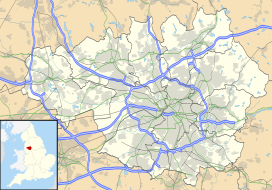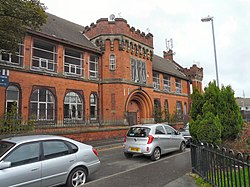Welcome to Visit Glodwick Places
The Walkfo guide to things to do & explore in Glodwick
![]() Visit Glodwick places using Walkfo for free guided tours of the best Glodwick places to visit. A unique way to experience Glodwick’s places, Walkfo allows you to explore Glodwick as you would a museum or art gallery with audio guides.
Visit Glodwick places using Walkfo for free guided tours of the best Glodwick places to visit. A unique way to experience Glodwick’s places, Walkfo allows you to explore Glodwick as you would a museum or art gallery with audio guides.
Visiting Glodwick Walkfo Preview
Glodwick is a multi-ethnic residential area in the south of Oldham, home to a large community of Pakistanis and British Pakistanis. It is marked architecturally by Oldham’s history with the Industrial Revolution, particularly cotton spinning. When you visit Glodwick, Walkfo brings Glodwick places to life as you travel by foot, bike, bus or car with a mobile phone & headphones.
Glodwick Places Overview: History, Culture & Facts about Glodwick
Visit Glodwick – Walkfo’s stats for the places to visit
With 91 audio plaques & Glodwick places for you to explore in the Glodwick area, Walkfo is the world’s largest heritage & history digital plaque provider. The AI continually learns & refines facts about the best Glodwick places to visit from travel & tourism authorities (like Wikipedia), converting history into an interactive audio experience.
Glodwick history
Etymology
The name Glodwick was recorded first as Glodic in the 1190s. The first element may be a Brittonic word related to Welsh clawdd, meaning “ditch, hedge” Gloddaeth in Wales may have a similar etymology. The second part of the name is harder to explain, but may be the Old English dic.
Medieval history
Glodwick was one of five parts of the thegnage estate of Kaskenmoor, held on behalf of King John by Roger de Montbegon and William de Nevill. The other parts of this estate were Crompton, Oldham, Sholver and Werneth. It later formed part of the township of Oldham within the ancient ecclesiastical parish of Prestwich-cum-Oldham.
Industrial revolution
In the late-19th and early-20th centuries, Glodwick provided a base for many of the cotton mills that made Oldham the most productive mill town in the world. Spinning companies like Samuel Milne, Lees & Wrigley, James Collinge & Sons and Bagley & Wright brought employment to the area.
Riots
In May 2001, Glodwick was the centre of controversy as it was at the heart of the Oldham Riots. Large scale rioting said to be fuelled by under-lying racial tensions between local white and South Asian communities.
Glodwick landmarks

Alexandra Park is one of Oldham’s best-known landmarks. The Glodwick Pool is a purpose built structure administered by Oldham Community Leisure. St Mark’s Church stands on the hill above Oldham and is the parish church for the area.
Lowside Brickworks
Lowside Brickworks is a disused quarry that has been designated as a Site of special scientific interest. The site is only 3.5 acres (1.4 hectares) but has considerable geological interest. It has yielded bivalves from the Carboniferous period showing how they interacted with sediment.
Why visit Glodwick with Walkfo Travel Guide App?
![]() You can visit Glodwick places with Walkfo Glodwick to hear history at Glodwick’s places whilst walking around using the free digital tour app. Walkfo Glodwick has 91 places to visit in our interactive Glodwick map, with amazing history, culture & travel facts you can explore the same way you would at a museum or art gallery with information audio headset. With Walkfo, you can travel by foot, bike or bus throughout Glodwick, being in the moment, without digital distraction or limits to a specific walking route. Our historic audio walks, National Trust interactive audio experiences, digital tour guides for English Heritage locations are available at Glodwick places, with a AI tour guide to help you get the best from a visit to Glodwick & the surrounding areas.
You can visit Glodwick places with Walkfo Glodwick to hear history at Glodwick’s places whilst walking around using the free digital tour app. Walkfo Glodwick has 91 places to visit in our interactive Glodwick map, with amazing history, culture & travel facts you can explore the same way you would at a museum or art gallery with information audio headset. With Walkfo, you can travel by foot, bike or bus throughout Glodwick, being in the moment, without digital distraction or limits to a specific walking route. Our historic audio walks, National Trust interactive audio experiences, digital tour guides for English Heritage locations are available at Glodwick places, with a AI tour guide to help you get the best from a visit to Glodwick & the surrounding areas.
“Curated content for millions of locations across the UK, with 91 audio facts unique to Glodwick places in an interactive Glodwick map you can explore.”
Walkfo: Visit Glodwick Places Map
91 tourist, history, culture & geography spots
Glodwick historic spots | Glodwick tourist destinations | Glodwick plaques | Glodwick geographic features |
| Walkfo Glodwick tourism map key: places to see & visit like National Trust sites, Blue Plaques, English Heritage locations & top tourist destinations in Glodwick | |||
Best Glodwick places to visit
Glodwick has places to explore by foot, bike or bus. Below are a selection of the varied Glodwick’s destinations you can visit with additional content available at the Walkfo Glodwick’s information audio spots:
 | Textile Mill, Chadderton Half of the building was destroyed by fire on 11 July 1950. The remaining section continued to be used for cotton waste sorting by W. H. Holt and Son until 1988. |
 | Cowhill, Greater Manchester Cowhill (archaically Cow Hill) is a locality of Chadderton, in the Metropolitan Borough of Oldham, Greater Manchester. It is located 0.5 miles (0.80 km) southeast of the town centre close to its eastern boundary with Oldham. An ancient hamlet which grew into an industrial village, Cowhill is now a residential area and includes a large housing development, Crossley Estate. |
 | Hartford Mill Hartford Mill was a Grade II-listed building located off Block Lane, in the Freehold area of Oldham, UK. The mill was located in the Oldham area of Freehold and is Grade II listed above Block Lane. |
 | Manor Mill, Chadderton Manor Mill, Chadderton is an early twentieth century, five storey cotton spinning mill. It was taken over by the Lancashire Cotton Corporation in the 1930s and passed to Courtaulds in 1964. Production finished in 1990. |
 | Werneth Park Werneth Park is a public park in Oldham, Greater Manchester. It includes a Grade II* listed Community Centre, Music Rooms, Dame Sarah Lees Memorial, Gardens and sports facilities. |
 | Werneth Hall Werneth Hall is a Grade II* listed privately owned Jacobean manor house in Oldham, Greater Manchester. It was built in 17th century and is now owned by a private family. |
 | Royd Mill, Oldham Royd Mill, Oldham was built in 1907 and extended in 1912 and 1924. It was taken over by the Lancashire Cotton Corporation in the 1930s and passed to Courtaulds in 1964. The mill was demolished in 2015 to make way for a housing scheme. |
 | Orme Mill, Waterhead Orme Mill, Waterhead is a cotton spinning mill in Waterhead, Oldham, Greater Manchester. It was built in 1908 and was taken over by Lancashire Cotton Corporation in the 1930s. Production finished in 1960 and the mill was passed on to Ferranti in 1964. |
 | St James’ Church, Oldham St James’ Church is in Barry Street, Greenacres Moor, Oldham, Greater Manchester. It is an active Anglican parish church in the deanery of Oldham East, the archdeaconry of Rochdale, and the diocese of Manchester. The church is recorded in the National Heritage List for England as a designated Grade II listed building. |
 | Rifle Street drill hall, Oldham Rifle Street drill hall is a former military installation in Oldham, Oldham. It is a drill hall used to be used as a military drill hall for training purposes. |
Visit Glodwick plaques
![]() 12
12
plaques
here Glodwick has 12 physical plaques in tourist plaque schemes for you to explore via Walkfo Glodwick plaques audio map when visiting. Plaques like National Heritage’s “Blue Plaques” provide visual geo-markers to highlight points-of-interest at the places where they happened – and Walkfo’s AI has researched additional, deeper content when you visit Glodwick using the app. Experience the history of a location when Walkfo local tourist guide app triggers audio close to each Glodwick plaque. Explore Plaques & History has a complete list of Hartlepool’s plaques & Hartlepool history plaque map.